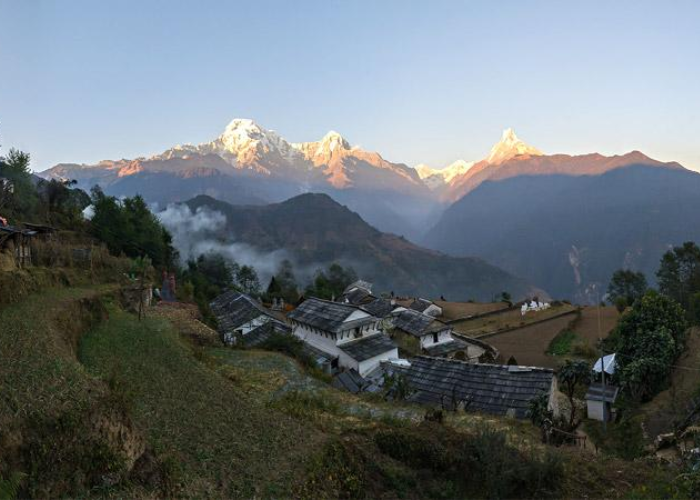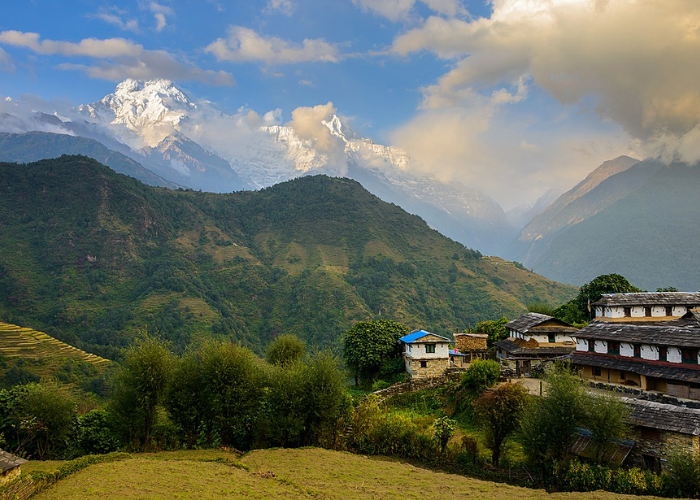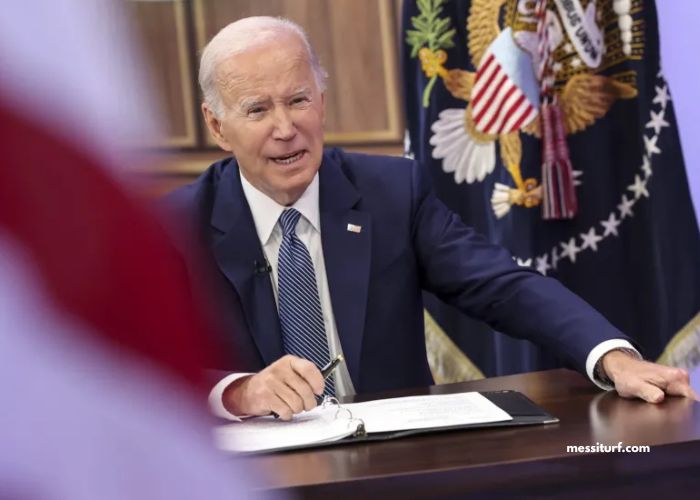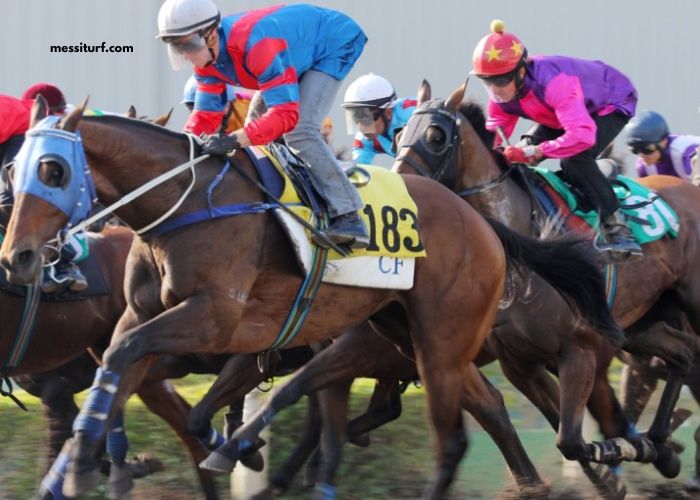Ghandruk trek is one of the most popular short treks in Nepal and is the major tourist destination located in the Annapurna region. It offers a perfect blend of natural beauty, cultural exploration, and trekking adventure. This trek is popular for its scenic view of the Himalayan mountain ranges, the traditional Gurung villages, and their lifestyle and hospitality.

It can be the best idea if you are planning to take your family on a trek as it is one of the easiest treks. This trek is beginner friendly which makes it a better option for those people who are just planning to witness the beauty of nature along with having fun. The maximum altitude of this trek is only 1940 m which means that there won’t be any problem with altitude sickness. This trek takes the easy route through greenery and rhododendron forests.
It doesn’t fail to provide panoramic views of Nilgiri, Himchuli, Machhapuchhre, and other majestic peaks. Moreover, you will get to experience the exotic beauty of rice fields and terraces. Not only that, this place provides the most beautiful early sunrise view over the Himalayas.
The trek takes an easy route through lush green forests of rhododendron, oak, and bamboo. The trail passes through several traditional Gurung villages, offering a glimpse into their lifestyle, culture, and hospitality. You can explore their traditional houses, visit the Gurung Museum, and witness their traditional dances and music. The trek also provides breathtaking panoramic views of the Annapurna and Dhaulagiri mountain ranges, including Nilgiri, Himchuli, and Machhapuchhre.
Major Highlights of Ghandruk Trek
- Easiest trekking trail in the Annapurna region
- Best option for families
- Cost-effective Trek
- Less strenuous
- Extremely best views of majestic Himalayas
- Chance to witness the local lifestyle of Gurungs
- Beautiful views of lush forests and rhododendrons

Daily Itinerary and Description
Day 1: Arrival at Kathmandu city (1400m)
Upon reaching the Tribhuvan International Airport, you will be received by our representative who will further drive you to the hotel where you will stay overnight. You might as well explore the “city of temples’ to gain a deeper knowledge of Nepalese heritage. You can explore popular cuisines of Nepal such as Dal Bhat, Momo, Newari Cuisine, and so on. Before starting with the journey the next morning, the trekking guide will discuss the itinerary, dos and don’ts, essentials, and required information with you so that you remain prepared.
Day 2: Explore Kathmandu
Kathmandu is enriched with numerous heritage sites and a culture that is worth experiencing. You will start your day by visiting the Swayambhunath Stupa which is situated on top of a hill. This stupa is one of the major attractions of the city which showcases the tourists with our ancient architecture and story.
Similarly, you will then visit Kathmandu Durbar Square, a UNESCO World Heritage Site. This place is popular among tourists for its history as this used to be the residence of the Nepali Royal family. This square built between the twelfth and eighteenth centuries is surrounded by many temples which is also another famous destination among tourists.
Next, you will visit the most sacred place of Kathmandu which happens to be Pashupathinath Temple. This Hindu Temple embraces the Pagoda style of architecture. The temple has numerous inscriptions, constructions, ashrams, and so on. One can witness the beauty of birth and death at the same time in this place as this is the place where both the birth and death rituals are performed.
Some of the popular destinations you can put on your list are Kapan Monastery, Boudhanath Stupa, Thamel, Budhanilkantha Temple, White Monastery, etc. After the full day of sightseeing, you will return to the hotel and spend the night there and get ready for the journey starting the next day.
Day 3: Drive to Pokhara (822m)
On the third day, after having breakfast at the hotel, you will begin your journey. The distance between Kathmandu to Pokhara is approximately 204 km and it will take 7 to 8 hours to reach there. You can stop for lunch on the midway where you can get food such as noodles, chapati, dal-bhat, chowmein, etc. You will come across a scenic journey while traveling through the Prithvi Highway. You will feel as though the mountains are getting closer and closer. Similarly, you will feel as though you are getting farther from the crowd and pollution. The sound of the Trishuli River flowing might ease all your pain away. This journey can be a lifetime experience. Upon reaching Pokhara, you will stay overnight at a hotel on the lakeside. You can enjoy an evening walk by the side of Phewa Lake and take proverbial advantage of the beautiful starry night. After this, you will have a proper dinner and get to bed so that your body is prepared to embark on the journey the next day.
Day 4: Drive to Nayapul (1070m) and Trek towards Ghandruk (1940m)
After having breakfast at Lakeside, Pokhara, you will drive towards Nayapul which is the gateway towards the trek via private transportation. This drive will take around 1 hour and 30 minutes. On the way, you can stop at different viewpoints to enjoy the astonishing views of nature. Similarly, you will get through picturesque villages and beautiful fields. Upon reaching Nayapul, the trek will be started towards Ghandruk which will approximately take around 5 to 6 hours. This trek will give you a sense of belongingness as you will be under the sky, in the beautiful weather all exposed to the raw form of nature. The rhododendron forest, the oaks, and the cultivated fields you will come across will rejuvenate and increase your contentment. After the tiring day, you will have warm local Gurung cuisine and get to your bed. You will stay overnight at Ghandruk.
Day 5: Explore Ghandruk Village
You will get to start your day with a beautiful sunrise from the village. Not only that, you will get to notice the morning rays bestowing their love upon flora and fauna. The Ghandruk village, also known as ‘Dhungeni village’ among locals has its own story to recite to the visitors through the green vegetables grown all over the villages, the rich Gurung culture, and its originality.
You can devote yourself to the temples, shrines, and farmhouses of this place. If you are a keen enthusiast of history, you can also explore Ghandruk’s historic and modern-day Gurkha connections with the help of locals. Similarly, you can visit two traditional museums that offer you to see the cultural artifacts of Gurungs. You can also dress up like Gurung and click pictures to take it as a memento. You can visit Meshrom Baraha Temple from the top of which the magnificent view of the Himalayas, villages, and farms can be observed. After the entire day of Ghandruk village exploration, you can enjoy local cuisines like Dal-Bhat or Dhido and local chicken. Similarly, you can indulge yourself in their cultural music and dances. Then you will stay overnight in Ghandruk.
Day 6: Trek from Ghandruk to Pothana (2005m)
The early sunrise is truly a mesmerizing sight that is worth waking up for. As you enjoy your breakfast with a panoramic view of the sun rising from behind the mountains, you will feel a sense of peace and tranquility that is hard to describe in words. The trek downhill toward the Modi Khola River will allow you to take in the stunning natural surroundings as you make your way toward the villages of Landruk and Tolka. These beautiful ethnic Gurung villages will give you a glimpse into the unique culture and way of life of the local people, and you will be greeted with warm hospitality and smiles along the way.
As you continue your trek, the Annapurna ranges will gradually come into view, and you will be left in awe of their grandeur and beauty. The trek through the dense forests to reach Pothana is an adventure in itself, as you make your way through winding paths and towering trees. The beautiful calls of barbets and cuckoos will accompany you on your journey, creating a symphony of sounds that will add to the enchanting atmosphere.
Reaching Pothana after a long day of trekking of around 3 to 4 hours will be a welcome relief, and the warm hospitality of the locals will make you feel right at home. The sound of the Modi Khola River and the friendly locals of the villages of Landruk and Tolka will remain etched in your memory forever, making this day one of the most memorable experiences of your lifetime. As you settle down for dinner and retire for the night in Pothana, you will feel grateful for the opportunity to have witnessed such breathtaking natural beauty and to have connected with the warm-hearted people of these charming villages.
Day 7: Trek from Pothana to Phedi and Drive to Pokhara
This day will be the last day of the trek. You will start your day with a proper breakfast at Pothana. After that, you will trek down along a stone-paved path to reach another exciting place called Dhampus. Like Ghandruk, Dhampus is also a settlement of the Gurung community. The local lifestyle can be recognized during the journey. You will have to continue to walk through the forest of oak and rhododendron till you reach Phedi. As you reach Phedi after 3 to 4 hours of walking, you will be driven to Pokhara from there. After 30 minutes of driving you will reach the hotel where you can get fresh food, eat and rest.
Day 8: Drive to Kathmandu
After having some hot breakfast in Pokhara, you ought to be ready to travel back to Kathmandu. You will reach Kathmandu after a drive of around 7 to 8 hours. As you reach, you can take a good evening walk to enjoy the view of Kathmandu and explore the nightlife here. You will spend the night in Kathmandu.
Day 9: Final Departure
On the ninth day, you will bid farewell to Nepal. One of our representatives will drive you to the Tribhuvan International Airport. Our representative will make sure that you are taken to the airport to the best of your comfort.
We hope your trip was enjoyable and wish you a safe return.
Some FAQs about Ghandruk Trek
- What are some of the local cuisines at Ghandruk that one must not miss out on?
One must not miss out on the traditional dish called Dhindo, which is made from buckwheat or maize and served with chicken or meat curry. This dish is a staple food of the Gurung community, which is the dominant ethnic group in Ghandruk. Another local delicacy that one must try is Thakali food, which is an authentic cuisine of the Thakali community. It consists of various dishes like dal bhat (lentil soup with rice), achar (pickle), and roti (flatbread). Thakali food is known for its unique taste and aroma and is a must-try for anyone visiting the region. Apart from Dhindo and Thakali food, one can also indulge in the special momos that are made in Ghandruk. These are steamed or fried dumplings filled with vegetables or meat and are popular snacks among locals and tourists alike.
Gurung bread is another popular food item that one must try while in Ghandruk. It is a type of flatbread made from buckwheat or millet flour and is a specialty of the Gurung community. Gurung bread has a unique texture and flavor and is often served with honey or butter. It is a great source of carbohydrates and provides energy for trekkers who need to refuel during long and tiring journeys.
- What are the types of clothes that I must take for the trek?
When packing for the Ghandruk trek, it’s important to consider the weather and temperature changes that you may experience during the trek. It’s recommended to pack quick-drying t-shirts that are made of breathable materials like polyester or nylon. These materials can wick away sweat and moisture from your skin, keeping you cool and comfortable during the trek. Avoid cotton T-shirts as they tend to absorb moisture and take longer to dry. Similar to t-shirts, it’s recommended to pack trekking pants that are made of quick-drying and breathable materials. Cargo pants with multiple pockets can also come in handy to carry small essential items. Carry a jacket with you because you might need it for the chilly weather during the evening as you go up the altitude. Also, remember to pack light because you will have to carry the bag throughout the trek and you must pack rationally.
Referance: https://abovethehimalaya.com/ghandruk-trek.html



